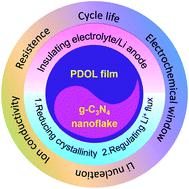当前位置:
X-MOL 学术
›
Sustain. Energy Fuels
›
论文详情
Our official English website, www.x-mol.net, welcomes your
feedback! (Note: you will need to create a separate account there.)
In situ synthesis of graphitic C3N4–poly(1,3-dioxolane) composite interlayers for stable lithium metal anodes
Sustainable Energy & Fuels ( IF 5.0 ) Pub Date : 2021-3-25 , DOI: 10.1039/d1se00212k Zilong Zhuang 1, 2, 3, 4, 5 , Yating Tang 1, 2, 3 , Bowei Ju 1, 2, 3 , Feiyue Tu 1, 2, 3
Sustainable Energy & Fuels ( IF 5.0 ) Pub Date : 2021-3-25 , DOI: 10.1039/d1se00212k Zilong Zhuang 1, 2, 3, 4, 5 , Yating Tang 1, 2, 3 , Bowei Ju 1, 2, 3 , Feiyue Tu 1, 2, 3
Affiliation

|
Lithium metal anodes (LMAs) possess the largest energy density among all anode candidates, while dendrite growth is a huge barrier in the direct application of LMAs in batteries. Herein, an ultrathin graphitic C3N4–poly(1,3-dioxolane) (CN–PDOL) composite interlayer was in situ synthesized by cationic ring-opening polymerization upon lithium metal anodes. Flexible PDOL could isolate electrolytes, remitting the corrosion reactions and consumption of electrolytes, while g-C3N4 nanoflakes could reduce the crystallinity of PDOL, increase ion-conductivity and uniform Li-ion fluxes. At a current density of 3 mA cm−2, the synergistic effect of CN and PDOL could enable 850 h stable Li plating/stripping behavior at an overpotential of 70 mV. In this work, a facile and accessible design of a composite buffer layer was developed for lithium metal anodes, which might be of interest to a broad community investigating surface modifications.
中文翻译:

用于稳定锂金属阳极的石墨C3N4–聚(1,3-二氧戊环)复合中间层的原位合成
锂金属阳极(LMA)在所有候选阳极中具有最大的能量密度,而枝晶的生长是将LMA直接应用于电池的巨大障碍。本文中,通过锂金属阳极上的阳离子开环聚合原位合成了超薄石墨C 3 N 4-聚(1,3-二氧戊环)(CN-PDOL)复合中间层。柔性PDOL可以隔离电解质,减轻腐蚀反应并减少电解质的消耗,而gC 3 N 4纳米片则可以降低PDOL的结晶度,提高离子电导率和均匀的锂离子通量。在3 mA cm -2的电流密度下,CN和PDOL的协同作用可在70 mV的超电势下实现850 h稳定的Li镀/剥离行为。在这项工作中,开发了一种适用于锂金属阳极的复合缓冲层的简便设计,这对于研究表面修饰的广大社区可能会很感兴趣。
更新日期:2021-04-09
中文翻译:

用于稳定锂金属阳极的石墨C3N4–聚(1,3-二氧戊环)复合中间层的原位合成
锂金属阳极(LMA)在所有候选阳极中具有最大的能量密度,而枝晶的生长是将LMA直接应用于电池的巨大障碍。本文中,通过锂金属阳极上的阳离子开环聚合原位合成了超薄石墨C 3 N 4-聚(1,3-二氧戊环)(CN-PDOL)复合中间层。柔性PDOL可以隔离电解质,减轻腐蚀反应并减少电解质的消耗,而gC 3 N 4纳米片则可以降低PDOL的结晶度,提高离子电导率和均匀的锂离子通量。在3 mA cm -2的电流密度下,CN和PDOL的协同作用可在70 mV的超电势下实现850 h稳定的Li镀/剥离行为。在这项工作中,开发了一种适用于锂金属阳极的复合缓冲层的简便设计,这对于研究表面修饰的广大社区可能会很感兴趣。













































 京公网安备 11010802027423号
京公网安备 11010802027423号